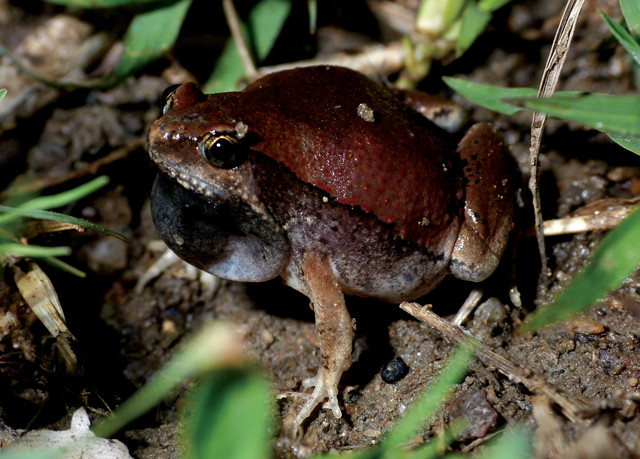
by Sarah Derouin Wednesday, November 15, 2017

Certain frog lineages, including the family Microhylidae to which this male Microhyla rubra belongs, flourished after the dinosaur extinction left environmental niches open. Credit: L. Shyamal, CC BY-SA 3.0.
Frogs make up almost 90 percent of amphibians, and with 6,775 described species, frogs are considered one of the most diverse groups of vertebrates on the planet. In a new study in Proceedings of the National Academy of Sciences, researchers indicate that frogs’ rapid diversification stems back to the Cretaceous-Paleogene (K-Pg, formerly the K-T) boundary, about 66 million years ago, when nonavian dinosaurs and many other animals went extinct.
The extinction event is thought to have resulted from the combined effects of an impact and massive amounts of volcanism. Following the extinction, many environmental niches opened up, allowing other groups of animals to flourish.
To investigate how frogs evolved in the wake of the extinction, scientists conducted extensive gene sampling of more than 300 species of extant frogs to work out the lineage and diversification of frogs through time. They found that three clades of frogs — Hyloidea, Microhylidae and Natatanura — not only survived after the extinction event, but rapidly diversified.
“We think the world was quite impoverished as a result of the K-T event, and when the vegetation came back, angiosperms dominated. That’s when trees evolved to their full flowering,” said study co-author David Wake of the University of California, Berkeley, in a statement. Wake said that frogs found an abundance of new habitats in these trees, which likely provided protection from predators as well as a plethora of insects to eat.
© 2008-2021. All rights reserved. Any copying, redistribution or retransmission of any of the contents of this service without the expressed written permission of the American Geosciences Institute is expressly prohibited. Click here for all copyright requests.